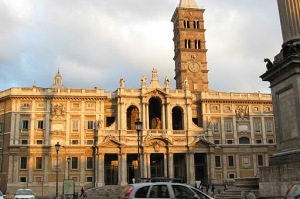The legend
Situated on the summit of the
Esquiline Hill,
St. Mary Major is the only one of the four
patriarchal basilicas to have retained its
paleo-Christian structures.
 |
| St. Mary Major (Santa Maria Maggiore), Esquiline Hill, Rome |
A wealthy but childless Roman couple,
John and his wife decided to leave their fortune to the Church. They often prayed to the
Virgin asking for guidance on how their wealth could be put to use.
The Virgin appeared to them on the night of August 4
th, 358 A.D. and told them that she wished a
basilica to be constructed on the
Esquiline Hill.
She would miraculously leave snow in the middle of the hot month of
August on the precise area in which she wanted the church. The next
morning
John and his wife and
Pope Liberius went to the top of the
Equiline Hill which had been covered with snow.
Pope Liberius immediately called for the construction of the
Basilica.
St. Mary Major (Santa Maria Maggiore) was completed in 360 A.D. Until 1969 the feast was known as
Dedicatio Sanctæ Mariæ ad Nives (Dedication of the Church of Our Lady of the Snows), a name that had become popular for the
Basilica in the
fourteenth century in connection with a legend about its origin. Pope Sixtus III (432-40) decided to build a new and more magnificent structure near (if not on) the site of
Liberius' former
Marian Church. In 1741, a congregation set up by Pope Benedict XIV proposed that the reading of the legend be removed from the Roman Breviary and that the original name, "Dedicatio Sanctæ Mariæ", be restored. This recommendation was implemented only in 1969.
The Structure
 |
| Interior - St. Mary Major |
The
monumental effect is due to the structure of the basilica and the
harmony that reigns among the principal architectural elements. The
basilica is divided into a
nave and
two side aisles
by two rows of precious columns. Above these columns runs the
skillfully wrought entablature, interrupted at the transept by the grand
arches erected for the building of
the Sistine and Pauline chapels. The area between the columns and the ceiling was once punctuated by
large windows,
half of which still remain, while the other half have been covered over
by a wall. Over the walled windows, today one can admire
frescos showing stories from the life of the
Virgin. Above the
window and
frescos,
a wooden frieze adorned with an exquisite inlay of cupid-like figures
riding bulls unites the cornice with the ceiling. The bulls are the
symbol of the
Borgia family; and the coat of arms of
Callixtus III and Alexander VI,
the Borgia popes, stand out at the center of the ceiling. The coffered ceiling was designed by
Giuliano Sangallo and later completed by his brother
Antonio.
In the
crypt under the
high altar lies the celebrated
relic known as the Holy Crib. A statue of Pope Pius IX kneeling before the ancient wooden pieces of the manger serves as an example to the faithful who come to see the first humble
crib of the Savior.


No comments:
Post a Comment